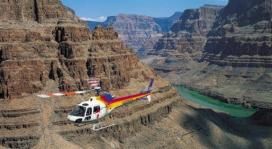Mitigating Air Tour Impacts at National Parks
Congress passed the National Parks Air Tour Management Act of 2000 in response to concerns that noise from air tours over national parks could impair visitors’ experiences and park resources. This law directs the Federal Aviation Administration (FAA) and the National Park Service (NPS) to develop air tour management plans (ATMPs) to mitigate or prevent the adverse impacts of commercial air tour aircraft noise in these protected lands and resources.
More recently, as part of the FAA Reauthorization and Reform Act, signed into law in 2012, a new tool was included as an alternative to an air tour management plan. This act allows for voluntary agreements with commercial air tour operators. The voluntary agreement must protect park resources and the visitor experience without compromising aviation safety or the air traffic control system.
The Challenge
The National Parks Air Tour Management Act states that the methodology adopted by a federal agency to assess air tour noise must be based on reasonable scientific methods.
If the FAA and NPS determine that a voluntary agreement is appropriate, it may be implemented without further administrative or environmental process. If a voluntary agreement is not adequately protecting park resources or visitor experiences, or is adversely affecting aviation safety or the national aviation system, then an ATMP must be developed.
The Solution
Volpe has leveraged its decades of experience in environmental engineering, noise measurement and assessment, and noise modeling, and is working collaboratively with the FAA and NPS to develop voluntary agreements, as well as tools and processes that enable these agencies to assess potential noise impacts on national parks.
To analyze the sound environment and compute various noise metrics when assessing potential noise impacts at national parks with air tours, the FAA and NPS turned to the Integrated Noise Model (INM), a software program developed by Volpe for the FAA and soon to be part of a new suite of FAA programs, known as the Aviation Environmental Design Tool (AEDT), that will allow for the evaluation of noise and emission interdependencies. Volpe continues to enhance its computer modeling capabilities by refining the INM/AEDT aircraft source noise database and performing advanced research into the factors that affect the level of aviation noise in complicated environments, such as national parks.
The Volpe team has also developed improved methods to quantify park soundscapes (natural and non‐natural ambient data) and to assess the effects of aircraft overflights on park visitor experience.
Volpe works with NPS, FAA, and air tour operators to develop voluntary agreements to reduce the impacts of air tours. Voluntary agreements identify the resources that must be protected, examine the impacts of current operations on those resources, and provide a set of conditions that will mitigate impacts. Currently, Volpe is conducting work to support voluntary agreements in Glen Canyon National Recreation Area (Arizona), Acadia National Park (Maine), Big Cypress National Preserve (Florida), and Biscayne National Park (Florida).
If an air tour management plan must be developed instead of a voluntary agreement, Volpe supports the development of environmental assessments and environmental impact statements that comply with the National Environmental Policy Act (NEPA).
The Impact
Volpe’s improved methods for measuring and analyzing environmental noise provide tools for the FAA and NPS to develop acceptable and effective measures to mitigate and prevent significant adverse impacts of commercial air tour aircraft noise on natural and cultural resources and visitor experiences in approximately 50 national parks and abutting tribal lands.
Customer

Federal Aviation Administration (FAA) Western Pacific Regional Office
National Park Service (NPS) Natural Sounds and Night Skies Division
